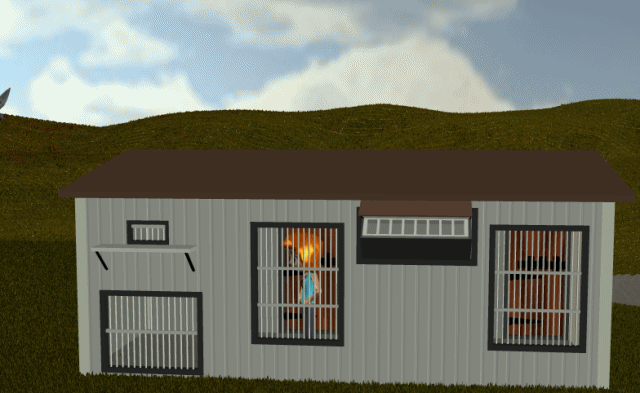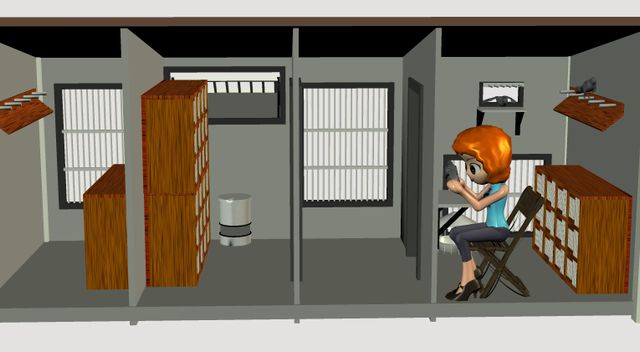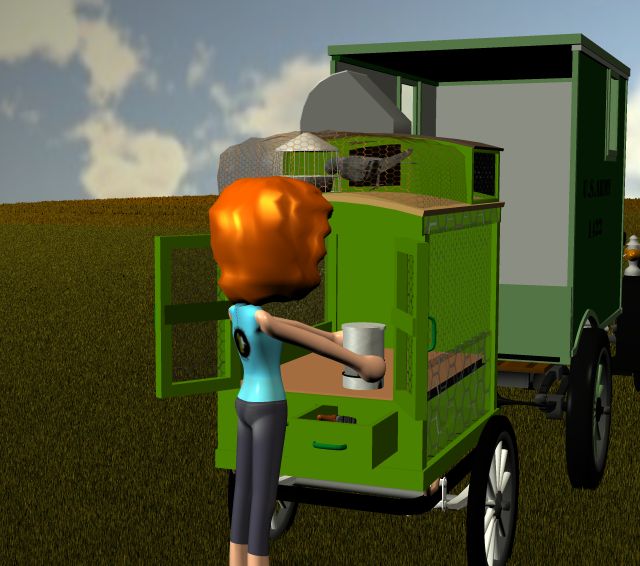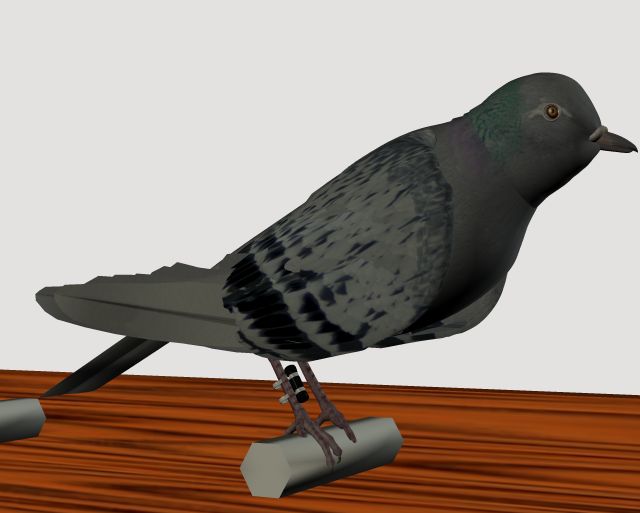Thursday, June 11, 2020
Pigeoneers and Pigeons 2
Continuing from here, with a few more pictures and a surprise.
A stationary loft served as the home base for the pigeons. They were trained in the stationary loft and learned to regard it as home.
 A typical military loft had three or four rooms.
A typical military loft had three or four rooms.
 The Detention Cell, with a separate entrance, held misbehaving or ill pigeons. The ill birds needed to be separated because the healthy pigeons would otherwise try to kill them. Birds are Darwinians. The bad birds were kept separate so they could be retrained without affecting the others. A central hall led to a main residence and a workroom. Each room had a set of nest boxes and a set of perches.
The Detention Cell, with a separate entrance, held misbehaving or ill pigeons. The ill birds needed to be separated because the healthy pigeons would otherwise try to kill them. Birds are Darwinians. The bad birds were kept separate so they could be retrained without affecting the others. A central hall led to a main residence and a workroom. Each room had a set of nest boxes and a set of perches.
 Nest boxes were just large enough for one pigeon to sleep and eat; but pigeons were generally free to fly around the rooms when not locked in for bedtime. Water and food were available in the main room.
Pigeons are a one-way communication device. When men were sent out to the field for reconnaissance or battle, they carried pigeons from the stationary loft. Sometimes they carried
in trailers,
Nest boxes were just large enough for one pigeon to sleep and eat; but pigeons were generally free to fly around the rooms when not locked in for bedtime. Water and food were available in the main room.
Pigeons are a one-way communication device. When men were sent out to the field for reconnaissance or battle, they carried pigeons from the stationary loft. Sometimes they carried
in trailers,
 and sometimes in carrying cages in trucks.
and sometimes in carrying cages in trucks.
 Each pigeon was equipped with a Message Capsule.
Each pigeon was equipped with a Message Capsule.
 When the field unit wanted to send reports or requests for support back to headquarters, they would write a message on a standard form, roll it tightly, insert it in the capsule, and launch the pigeon. Automatic communication, no radio waves, no visible transport on the ground.
= = = = =
The one-way-ness would limit modern uses, but a Guild of modern Pigeoneers could find ways to use pigeons for off-grid banking and communication. A load of pigeons could be taken to a Branch Bank or Branch Post Office at intervals, then launched back to the central office with checks or letters. A capsule could carry massive amounts of information in digital form (eg USB stick).
= = = = =
Surprise: During WW2 the Army's pigeoneers had bred and trained two-way pigeons, or more precisely two-home pigeons. The birds knew two locations. When released at point A they would fly to point B, and when released at B they would fly to A.
When the field unit wanted to send reports or requests for support back to headquarters, they would write a message on a standard form, roll it tightly, insert it in the capsule, and launch the pigeon. Automatic communication, no radio waves, no visible transport on the ground.
= = = = =
The one-way-ness would limit modern uses, but a Guild of modern Pigeoneers could find ways to use pigeons for off-grid banking and communication. A load of pigeons could be taken to a Branch Bank or Branch Post Office at intervals, then launched back to the central office with checks or letters. A capsule could carry massive amounts of information in digital form (eg USB stick).
= = = = =
Surprise: During WW2 the Army's pigeoneers had bred and trained two-way pigeons, or more precisely two-home pigeons. The birds knew two locations. When released at point A they would fly to point B, and when released at B they would fly to A.
 A typical military loft had three or four rooms.
A typical military loft had three or four rooms.
 The Detention Cell, with a separate entrance, held misbehaving or ill pigeons. The ill birds needed to be separated because the healthy pigeons would otherwise try to kill them. Birds are Darwinians. The bad birds were kept separate so they could be retrained without affecting the others. A central hall led to a main residence and a workroom. Each room had a set of nest boxes and a set of perches.
The Detention Cell, with a separate entrance, held misbehaving or ill pigeons. The ill birds needed to be separated because the healthy pigeons would otherwise try to kill them. Birds are Darwinians. The bad birds were kept separate so they could be retrained without affecting the others. A central hall led to a main residence and a workroom. Each room had a set of nest boxes and a set of perches.
 Nest boxes were just large enough for one pigeon to sleep and eat; but pigeons were generally free to fly around the rooms when not locked in for bedtime. Water and food were available in the main room.
Pigeons are a one-way communication device. When men were sent out to the field for reconnaissance or battle, they carried pigeons from the stationary loft. Sometimes they carried
in trailers,
Nest boxes were just large enough for one pigeon to sleep and eat; but pigeons were generally free to fly around the rooms when not locked in for bedtime. Water and food were available in the main room.
Pigeons are a one-way communication device. When men were sent out to the field for reconnaissance or battle, they carried pigeons from the stationary loft. Sometimes they carried
in trailers,
 and sometimes in carrying cages in trucks.
and sometimes in carrying cages in trucks.
 Each pigeon was equipped with a Message Capsule.
Each pigeon was equipped with a Message Capsule.
 When the field unit wanted to send reports or requests for support back to headquarters, they would write a message on a standard form, roll it tightly, insert it in the capsule, and launch the pigeon. Automatic communication, no radio waves, no visible transport on the ground.
= = = = =
The one-way-ness would limit modern uses, but a Guild of modern Pigeoneers could find ways to use pigeons for off-grid banking and communication. A load of pigeons could be taken to a Branch Bank or Branch Post Office at intervals, then launched back to the central office with checks or letters. A capsule could carry massive amounts of information in digital form (eg USB stick).
= = = = =
Surprise: During WW2 the Army's pigeoneers had bred and trained two-way pigeons, or more precisely two-home pigeons. The birds knew two locations. When released at point A they would fly to point B, and when released at B they would fly to A.
When the field unit wanted to send reports or requests for support back to headquarters, they would write a message on a standard form, roll it tightly, insert it in the capsule, and launch the pigeon. Automatic communication, no radio waves, no visible transport on the ground.
= = = = =
The one-way-ness would limit modern uses, but a Guild of modern Pigeoneers could find ways to use pigeons for off-grid banking and communication. A load of pigeons could be taken to a Branch Bank or Branch Post Office at intervals, then launched back to the central office with checks or letters. A capsule could carry massive amounts of information in digital form (eg USB stick).
= = = = =
Surprise: During WW2 the Army's pigeoneers had bred and trained two-way pigeons, or more precisely two-home pigeons. The birds knew two locations. When released at point A they would fly to point B, and when released at B they would fly to A.
At Fort Monmouth a true blue-blooded pigeon named Mister Corrigan was taken, whose ancestry was known for 525 pigeon years of life. 167 famous champion racing pigeons appeared in his pedigree, including the names of some famed army message carriers. On such aristocratic material Major John K. Shawvan, of the U. S. Signal Corps, set to work. A short while ago it was announced that under the Major's tutelage Mister Corrigan had made pigeon history. He flew twelve miles from his home loft to a small container around which crouched a small group of soldiers. Five minutes later this history making pigeon was winging his way back on the return trip to the loft he had left not many minutes before. Today Fort Monmouth claims to have a flock of nearly a hundred of the only two-way homing pigeons in the world—birds able to carry messages on round trips across battlefieldsThe article also describes a similar French project in more detail. Was this line of work continued or expanded later? I can't tell from online material, but two-way pigeons are definitely possible. (Nice choice of name for the main pigeon!) I'll bet you could train for more than two locations by using an aerial picture of the uniquely marked landing zones. Show a picture of Zone C, and the bird would know how to get there. = = = = = Poser models released at ShareCG.
Labels: Patient people, Patient things
